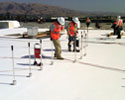Officially founded in 1898, Wichita, Kan.-based Friends University dates to the 1880s when the Christian Churches of Kansas began constructing a building west of Wichita to be the largest educational facility west of the Mississippi River. In 1887, Garfield University opened its doors to 500 students, but after graduating its first and only senior class, Garfield University closed in 1890 because of financial difficulties. The school was reorganized and opened again in March 1892 as Garfield Central Memorial University but closed Nov. 18, 1893.
After sitting vacant for five years, the building and surrounding lots were purchased by St. Louis businessman James M. Davis. Davis offered the building to the Kansas Society of Friends, a Quaker organization, on the condition the group raise $50,000 for the college's permanent endowment. The conditions were accepted, and Friends University officially opened its doors in September 1898.
Friends University continued operating as a Quaker institution until the 1930s when the school's governance was vested in an independent board of trustees. Since then, the university has continued to operate in an amicable but independent relationship with the Society of Friends. Currently, the university has about 1,000 students enrolled in its undergraduate programs.
Storm foes
In July 2009, baseball-sized hail severely damaged the university's Davis Hall roof system, causing more than $2 million in damage and destroying the ornate architectural metal and slate roof systems. Because of its experience with restoring similar historical projects and having been in business nearly as long as the university, Buckley Roofing Co. Inc., Wichita, was chosen to restore the magnificent building's roofing and architectural components.
"Buckley Roofing was awarded the contract because of its outstanding local reputation and expertise with working on historical structures," says Randy Doerksen, vice president of administration and finance for Friends University.
Buckley Roofing was honored to be chosen to lead the renovation project, as well.
"We are proud to have been chosen to complete the monumental renovation of this truly historical building," says Cleo Daugherty, sales and project manager for Buckley Roofing.
On April 19, 2010, scaffold erection by Safway® Services LLC, Tulsa, Okla., began at the building perimeter. Scaffolding was erected from the ground level to the 60-foot gutter line. It was especially challenging to set up scaffolding around the 148-foot-high clock tower, but it proved beneficial during the project for safe access to virtually all areas.
Buckley Roofing began its work May 5, 2010, by removing about 45,000 square feet of slate and two layers of 30-pound felt nailed with 12-gauge copper nails from the steep-slope decking. Deteriorated wood decking revealed after tear-off was repaired using similar materials. The entire roof deck then was overlaid with 1/2-inch-thick CDX plywood. Two layers of InterWrap® Inc.'s Titanium® UDL-30 synthetic underlayment were secured over the plywood using 1-inch plastic cap nails. Receiver-style 16-ounce copper eave flashing was installed to facilitate slate application before gutter installation.
Once flashing details were completed, the entire roof, including cones, tower and window eyebrows, received 18-inch random 1/4- to 3/8-inch-thick Hilltop Vermont Black slate with 3-inch head lap; a 7 1/2-inch exposure was secured using 12-gauge copper nails. Equipment developed in-house enabled slate application on four steep-slope conical roof systems to be performed with no damage to newly installed slate. Specially designed and fabricated mobilized walk boards on flotation tires greatly contributed to the product's overall integrity.
Concurrent to the roofing operation, about 5,000 square feet of massive sheet-metal cornice details, copper guttering, finials, spire, coping caps and gable fascia were being removed from gutter lines, turrets, dormers and the tower. The removal of materials revealed hidden challenges because of the aged heavy timber and brick substructure. Substructure conditions ranged from fair to poor; many areas required bracing and shoring. To withstand the high winds of Kansas, Buckley Roofing designed and fabricated unique brackets to support existing structure and architectural details. Tuck pointing was necessary in several locations to repair mortar and stabilize brick behind the cornice. All work was performed to maintain and preserve the existing structure.
Old and new agree to agree
The university arguably is one of the most complex and ornate buildings constructed in the Midwest, and Buckley Roofing recommended using fiberglass-reinforced plastic (FRP) in lieu of architectural metal components for the straight and curved cornice, turret finials, peak finials, conical roofs and spires. FRP offers minimal maintenance, no painting, hail resistance and uniform symmetry virtually unobtainable using metal. After in-depth deliberation, the university in collaboration with the National Historical Society approved the FRP solution.
Buckley Roofing collaborated with FRP manufacturer South's Finest LLC to craft 45 molds, producing hundreds of fiberglass components each modeled to match the metal counterparts. Buckley Roofing designed and South's Finest produced a multipart cornice allowing symmetry unmatched by the original installation. The most notable is the symmetry of the conical roofs located at each corner of the tower. Buckley Roofing furnished computer-aided design drawings of each architectural detail to South's Finest, and the engineers converted the drawings to 3-D for FRP mold development and product manufacturing. Ultimately, the FRP products proved to be a striking solution for the unique, beautiful building.
Storm woes
In Kansas, where wind, hail, rain and snow prevail, the weather throughout the project was unforgiving. The poor deck and abnormal weather delays stretched the project's deadline two months past the estimated eight months. Many roof elevations were workable only by crane, and crane operations involving a man basket ceased when winds exceeded 18 mph. During the project, 30-mph wind gusts were more frequent than not.
However, safe equipment and practices enabled completion of the project without injury. The height and complexity of the project spurred safety concerns from the onset. Scaffolding and rigging were inspected daily before access was allowed. Following inspections, a crew meeting was held to identify and address possible hazards that could arise during the day.
Occupational Safety and Health Administration- (OSHA-) compliant safety equipment was used, and rigging methods were strictly followed with additional backup rigging doubling the protection for every worker of the 18- to 22-member crew. Specially mobilized 10-foot-wide work platforms suspended independently from ridges provided a safe, stable application for felts and slate. OSHA performed two random inspections without issuing violations.
"It's most important that at the end of the day everyone can return home to their families in the same condition they began the day," says Ed Frederick, Buckley Roofing's owner.
From storm woes to kudos
Despite unexpected weather delays and challenges, Buckley Roofing restored Friends University to its magnificent condition, emulating and exceeding craftsmanship exhibited by workmen more than a century ago.
"From beginning to end, Buckley Roofing partnered with the university to restore the building to a better condition than before the storm and never sacrificed quality," Doerksen says.
"Being able to participate in the renovation of this historic and magnificently ornate building was an honor," Daugherty says.
For demonstrating superior craftsmanship, Buckley Roofing was awarded an NRCA 2012 Gold Circle Award in the Outstanding Workmanship—Steep-slope category. Buckley Roofing previously won in the Outstanding Workmanship—Steep-slope category for the Exploration Place project, Wichita, in 2002.
"We are extremely proud to win the Gold Circle Award a second time," Daugherty says.
Chrystine Elle Hanus is Professional Roofing's associate editor and NRCA's director of communications.
Project name: Friends University's Davis Hall
Project location: Wichita, Kan.
Project duration: April 2010–March 2011
Roof system types: Copper; fiberboard reinforced plastic; slate
Roofing contractor: Buckley Roofing Co. Inc., Wichita
Product manufacturers: Hilltop Slate, Middle Granville, N.Y.; InterWrap Inc.,
Vancouver, British Columbia; South's Finest LLC, Quitman, Ga.
Gold Circle Awards category: Outstanding Workmanship—Steep-slope



